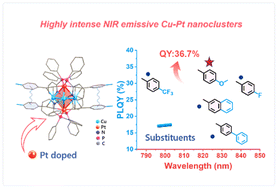Highly intense NIR emissive Cu4Pt2 bimetallic clusters featuring Pt(i)–Cu4–Pt(i) sandwich kernel†
Abstract
Metal nanoclusters (NCs) capable of near-infrared (NIR) photoluminescence (PL) are gaining increasing interest for their potential applications in bioimaging, cell labelling, and phototherapy. However, the limited quantum yield (QY) of NIR emission in metal NCs, especially those emitting beyond 800 nm, hinders their widespread applications. Herein, we present a bright NIR luminescence (PLQY up to 36.7%, ∼830 nm) bimetallic Cu4Pt2 NC, [Cu4Pt2(MeO–C6H5–C![[triple bond, length as m-dash]](https://www.rsc.org/images/entities/char_e002.gif) C)4(dppy)4]2+ (dppy = diphenyl-2-pyridylphosphine), with a high yield (up to 67%). Furthermore, by modifying the electronic effects of R in RC
C)4(dppy)4]2+ (dppy = diphenyl-2-pyridylphosphine), with a high yield (up to 67%). Furthermore, by modifying the electronic effects of R in RC![[triple bond, length as m-dash]](https://www.rsc.org/images/entities/char_e002.gif) C− (R = MeO–C6H5, F–C6H5, CF3–C6H5, Nap, and Biph), we can effectively modulate phosphorescence properties, including the PLQY, emission wavelength, and excited state decay lifetime. Experimental and computational studies both demonstrate that in addition to the electron effects of substituents, ligand modification enhances luminescence intensity by suppressing non-radiation transitions through intramolecular interactions. Simultaneously, it allows the adjustment of emitting wavelengths by tuning the energy gaps and first excited triplet states through intermolecular interactions of ligand substituents. This study provides a foundation for rational design of the atomic-structures of alloy metal NCs to enhance their PLQY and tailor the PL wavelength of NIR emission.
C− (R = MeO–C6H5, F–C6H5, CF3–C6H5, Nap, and Biph), we can effectively modulate phosphorescence properties, including the PLQY, emission wavelength, and excited state decay lifetime. Experimental and computational studies both demonstrate that in addition to the electron effects of substituents, ligand modification enhances luminescence intensity by suppressing non-radiation transitions through intramolecular interactions. Simultaneously, it allows the adjustment of emitting wavelengths by tuning the energy gaps and first excited triplet states through intermolecular interactions of ligand substituents. This study provides a foundation for rational design of the atomic-structures of alloy metal NCs to enhance their PLQY and tailor the PL wavelength of NIR emission.

- This article is part of the themed collection: 2024 Chemical Science HOT Article Collection


 Please wait while we load your content...
Please wait while we load your content...